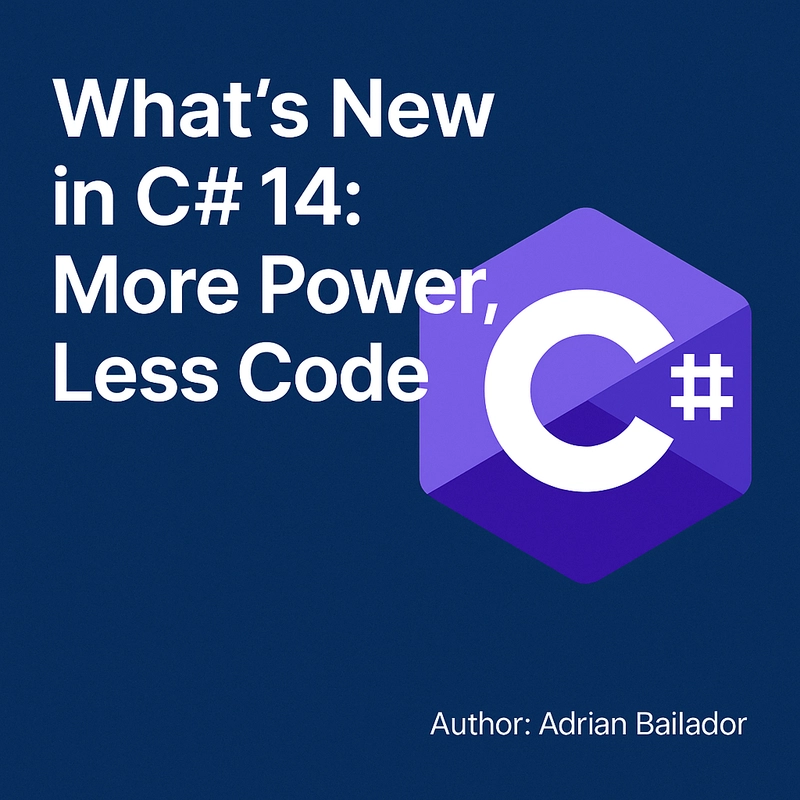What’s New in C# 14: More Power, Less Code
The .NET ecosystem keeps evolving, and with the release of C# 14 alongside .NET 10, developers now have a fresh set of features that make the language even more expressive, concise, and powerful. In this post, I’ll walk you through the key improvements in this new version, with clear and practical examples. 1. Extension Members: Beyond Extension Methods C# 14 takes extension methods to the next level. You can now define properties, indexers and more within extension blocks, giving you more power to enhance existing types: public static class EnumerableExtensions { extension(IEnumerable source) { public bool IsEmpty => !source.Any(); public T this[int index] => source.Skip(index).First(); } } This is great for encapsulating reusable logic without touching the original type. 2. Improved Null-Conditional Assignment The ??= operator gets an upgrade – it now works with more complex null-conditional expressions: myObject?.Property ??= defaultValue; A clean and elegant way to assign values only when something is null, without needing if statements. 3. nameof Supports Open Generic Types You can now get the name of an open generic type using nameof: nameof(List); // Returns "List" Very handy for logging, code generation, or validation scenarios. 4. Better Support for Span and ReadOnlySpan C# 14 expands implicit conversions between Span, ReadOnlySpan, and arrays (T[]), making high-performance memory operations safer and easier to work with. 5. Lambdas with Modifiers Lambdas can now use modifiers like ref, out, in or scoped without needing explicit parameter types: TryParse parse = (text, out result) => int.TryParse(text, out result); This is especially useful with APIs that involve references or output parameters. 6. Accessing Auto-Property Backing Fields with field A subtle but useful feature: you can now access the backing field of an auto-implemented property directly: public string Message { get; set => field = value ?? throw new ArgumentNullException(nameof(value)); } This allows you to add validation without having to declare a private field manually. 7. Partial Constructors and Events The concept of partial members is expanding — you can now declare partial constructors and partial events. This is particularly useful in code generation scenarios or when working with partially generated classes.

The .NET ecosystem keeps evolving, and with the release of C# 14 alongside .NET 10, developers now have a fresh set of features that make the language even more expressive, concise, and powerful. In this post, I’ll walk you through the key improvements in this new version, with clear and practical examples.
1. Extension Members: Beyond Extension Methods
C# 14 takes extension methods to the next level. You can now define properties, indexers and more within extension blocks, giving you more power to enhance existing types:
public static class EnumerableExtensions
{
extension<T>(IEnumerable<T> source)
{
public bool IsEmpty => !source.Any();
public T this[int index] => source.Skip(index).First();
}
}
This is great for encapsulating reusable logic without touching the original type.
2. Improved Null-Conditional Assignment
The ??= operator gets an upgrade – it now works with more complex null-conditional expressions:
myObject?.Property ??= defaultValue;
A clean and elegant way to assign values only when something is null, without needing if statements.
3. nameof Supports Open Generic Types
You can now get the name of an open generic type using nameof:
nameof(List<>); // Returns "List"
Very handy for logging, code generation, or validation scenarios.
4. Better Support for Span and ReadOnlySpan
C# 14 expands implicit conversions between Span, ReadOnlySpan, and arrays (T[]), making high-performance memory operations safer and easier to work with.
5. Lambdas with Modifiers
Lambdas can now use modifiers like ref, out, in or scoped without needing explicit parameter types:
TryParse<int> parse = (text, out result) => int.TryParse(text, out result);
This is especially useful with APIs that involve references or output parameters.
6. Accessing Auto-Property Backing Fields with field
A subtle but useful feature: you can now access the backing field of an auto-implemented property directly:
public string Message
{
get;
set => field = value ?? throw new ArgumentNullException(nameof(value));
}
This allows you to add validation without having to declare a private field manually.
7. Partial Constructors and Events
The concept of partial members is expanding — you can now declare partial constructors and partial events. This is particularly useful in code generation scenarios or when working with partially generated classes.































































































































































![[The AI Show Episode 143]: ChatGPT Revenue Surge, New AGI Timelines, Amazon’s AI Agent, Claude for Education, Model Context Protocol & LLMs Pass the Turing Test](https://www.marketingaiinstitute.com/hubfs/ep%20143%20cover.png)



























































































































![[FREE EBOOKS] AI and Business Rule Engines for Excel Power Users, Machine Learning Hero & Four More Best Selling Titles](https://www.javacodegeeks.com/wp-content/uploads/2012/12/jcg-logo.jpg)










































































































































































































































![Hostinger Horizons lets you effortlessly turn ideas into web apps without coding [10% off]](https://i0.wp.com/9to5mac.com/wp-content/uploads/sites/6/2025/04/IMG_1551.png?resize=1200%2C628&quality=82&strip=all&ssl=1)




![This new Google TV streaming dongle looks just like a Chromecast [Gallery]](https://i0.wp.com/9to5google.com/wp-content/uploads/sites/4/2025/04/thomson-cast-150-google-tv-1.jpg?resize=1200%2C628&quality=82&strip=all&ssl=1)












![Apple Drops New Immersive Adventure Episode for Vision Pro: 'Hill Climb' [Video]](https://www.iclarified.com/images/news/97133/97133/97133-640.jpg)

![Most iPhones Sold in the U.S. Will Be Made in India by 2026 [Report]](https://www.iclarified.com/images/news/97130/97130/97130-640.jpg)




































































































































